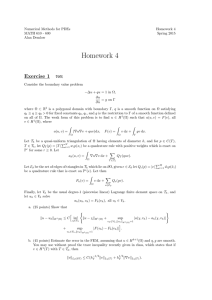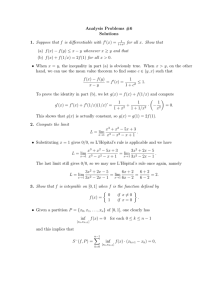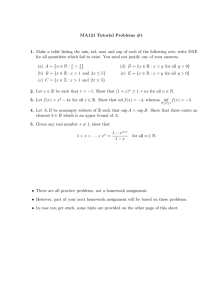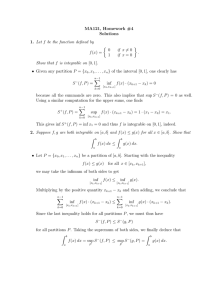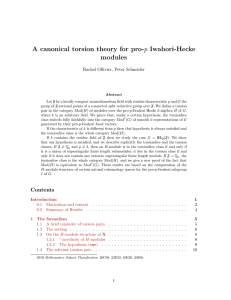Math 515 Professor Lieberman November 29, 2004 HOMEWORK #13 SOLUTIONS
advertisement
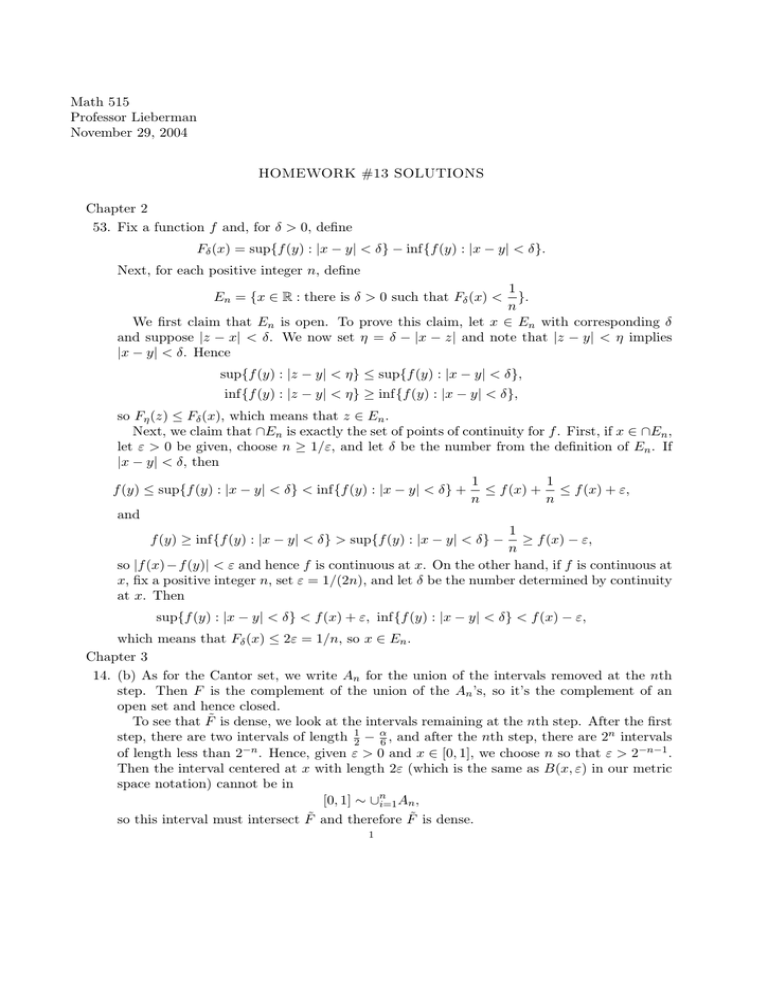
Math 515
Professor Lieberman
November 29, 2004
HOMEWORK #13 SOLUTIONS
Chapter 2
53. Fix a function f and, for δ > 0, define
Fδ (x) = sup{f (y) : |x − y| < δ} − inf{f (y) : |x − y| < δ}.
Next, for each positive integer n, define
1
}.
n
We first claim that En is open. To prove this claim, let x ∈ En with corresponding δ
and suppose |z − x| < δ. We now set η = δ − |x − z| and note that |z − y| < η implies
|x − y| < δ. Hence
En = {x ∈ R : there is δ > 0 such that Fδ (x) <
sup{f (y) : |z − y| < η} ≤ sup{f (y) : |x − y| < δ},
inf{f (y) : |z − y| < η} ≥ inf{f (y) : |x − y| < δ},
so Fη (z) ≤ Fδ (x), which means that z ∈ En .
Next, we claim that ∩En is exactly the set of points of continuity for f . First, if x ∈ ∩En ,
let ε > 0 be given, choose n ≥ 1/ε, and let δ be the number from the definition of En . If
|x − y| < δ, then
1
1
f (y) ≤ sup{f (y) : |x − y| < δ} < inf{f (y) : |x − y| < δ} + ≤ f (x) + ≤ f (x) + ε,
n
n
and
1
f (y) ≥ inf{f (y) : |x − y| < δ} > sup{f (y) : |x − y| < δ} − ≥ f (x) − ε,
n
so |f (x)−f (y)| < ε and hence f is continuous at x. On the other hand, if f is continuous at
x, fix a positive integer n, set ε = 1/(2n), and let δ be the number determined by continuity
at x. Then
sup{f (y) : |x − y| < δ} < f (x) + ε, inf{f (y) : |x − y| < δ} < f (x) − ε,
which means that Fδ (x) ≤ 2ε = 1/n, so x ∈ En .
Chapter 3
14. (b) As for the Cantor set, we write An for the union of the intervals removed at the nth
step. Then F is the complement of the union of the An ’s, so it’s the complement of an
open set and hence closed.
To see that F̃ is dense, we look at the intervals remaining at the nth step. After the first
step, there are two intervals of length 12 − α6 , and after the nth step, there are 2n intervals
of length less than 2−n . Hence, given ε > 0 and x ∈ [0, 1], we choose n so that ε > 2−n−1 .
Then the interval centered at x with length 2ε (which is the same as B(x, ε) in our metric
space notation) cannot be in
[0, 1] ∼ ∪ni=1 An ,
so this interval must intersect F̃ and therefore F̃ is dense.
1
2
To compute the measure of F , we note that each An is the union of 2n−1 intervals of
length α3−n , so mAn = α2n−1 3−n . It follows that
∞
X
2n−1
mF = 1 −
α n = 1 − α.
3
n=1
Chapter 7
27. Define ρ(x, F ) as in the hint and set f (x) = ρ(x, F ). To see that f is continuous, we let
ε > 0 be given, and set δ = ε/2. If ρ(x, z) < δ, then there is point y ∈ F such that
ρ(x, y) < f (x) + ε/2. It follows that
ε
f (z) = ρ(z, F ) ≤ ρ(z, y) ≤ ρ(x, y) + ρ(z, x) < f (x) + + δ = f (x) + ε,
2
and, similarly, f (x) < f (z) + ε, so |f (x) − f (z)| < ε.
⇒: We’ll prove the contrapositive: If ρ(F, K) = 0, then F ∩ K 6= ∅. If ρ(F, K) = 0,
then inf f = 0. Since f is continuous and K is compact, there is a point x ∈ K such
that ρ(x, F ) = 0 (by Proposition 100). Hence there is a sequence hyn i in F such that
ρ(x, yn ) → 0. This implies that yn → x and hence x is in F , so F ∩ K 6= ∅.
⇐: Again, we prove the contrapositive: If F ∩ K 6= ∅, then ρ(F, K) = 0. Let x ∈ F ∩ K
and y = x. Then ρ(F, K) ≤ ρ(x, y) = 0, so ρ(F, K) = 0.
33. (a) Let En be the generalized Cantor set, from problem 3.14b, with α = 1/n. Then En is
nowhere dense since ∼ (E n ) = Ẽn is dense, and mEn = 1 − 1/n.
(b) Take E = ∪En , with En from part (a).
38. (a) Let hfk i be a sequence in Fn which converges in C, and, for each k, let xk be a point
such that 0 ≤ xk ≤ 1 − 1/n and |f (x) − f (xk )| ≤ n(x − xk ) for all x ∈ [xk , 1). Then, there
is a convergent subsequence hxkm i of hxk i with limit x0 . Clearly 0 ≤ x0 ≤ 1 − 1/n. Also,
given ε > 0, there is an integer M such that |f (z) − fkm (z)| ≤ ε if m ≥ M , in which case
|f (x) − f (x0 )| ≤ |f (x) − fkm (x)| + |fkm (x) − fkm (xkm )| + |fkm (xkm ) − f (xkm )| + |f (xkm ) − f (x0 )|
≤ 2ε + n(x − xkm ) + |f (xkm ) − f (x0 )|
for all x ≥ max{x0 , xkm }. If x = x0 , then
|f (x) − f (x0 )| = 0 = n(x − x0 ).
On the other hand, if x > x0 , then there is an integer M1 such that xkm ≤ x for m ≥ M1
and an integer M2 such that n|xkm − x0 | ≤ ε if m ≥ M2 . It follows that
|f (x) − f (x0 )| ≤ n(x − x0 ) + 4ε.
Since ε is arbitrary, it follows that |f (x)−f (x0 )| ≤ n(x−x0 ) for all x ∈ [x0 , 1) and therefore
f ∈ Fn .
(b) First, let g ∈ C and let ε > 0 be given. Then there is δ > 0 such that |x − y| < δ
implies |f (x) − f (y)| < ε/4. We then choose the integer M > 2/ε and let ϕ be the function
which agrees with f at each number of the form i/M with i ∈ {0, 1, . . . , M } and is linear
between these points. If x = i/M for such an i, then f (x) = ϕ(x) and if x is between two
such numbers i/M and (i + 1)/M , then |ϕ(x) − ϕ(i/M )| ≤ ε/4, so
ε
|f (x) − ϕ(x)| ≤ |f (x) − f (i/M )| + |f (i/M ) − ϕ(x)| ≤ .
2
Next, we show that each line segment in the graph of ϕ can be approximated by the graph
of a polygonal function with right-hand derivative everywhere greater than n is absolute
3
value. First note that, without loss of generality, we may assume that the slope of each
line segment making up the graph of ϕ has absolute value less than n. With η < ε/2 to be
further specified, we define ψ as follows: start with ψ((i − 1)/M ) = ϕ((i−)/M ), then take
ψ to be linear with slope 2n until it intersects the graph of ϕ + η. Then take ψ to be linear
with slope −2n until it intersect the graph of ϕ − η. Continue alternating these slopes until
you get to i/M and observe that η can be adjusted so that ψ(i/M ) = ϕ(i/M ).
(c) If f is continuous and has finite derivative on the right for some x0 ∈ [0, 1), choose
N so large that x0 ≤ 1 − 1/N . Since f 0 (x0 ) is finite, there is a positive δ such that
|f (x) − f (x0 )| ≤ (|f 0 (x0 )| + 1)(x − x0 ) if x ∈ [x0 , x0 + δ]. Now take n ≥ max{N, |f 0 (x0 )| + 1}
so that sup |f − f (x0 )| ≤ n/δ. It follows that
|f (x) − f (x0 )| ≤ n(x − x0 )
for all x ≥ x0 and hence f ∈ Fn . Therefore D ⊂ ∪Fn . Each Fn is nowhere dense by part
(b), so D is of first category.
(d) We know that C is a complete metric space and D is of first category in C. By the
Baire Category Theorem C is of second category, so D can’t be all of C, and hence there
is a continuous function which is nowhere differentiable.




